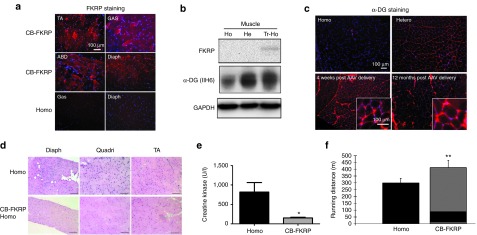Figure 2.

Improvement of muscle pathology and function after delivery of AAV9-CB-fukutin-related protein (FKRP)-myc vector in neonates. The AAV9-CB-FKRP-myc vector (1 × 1011 vg/pup) was delivered into 3-day-old homozygous pups. (a) Overexpression of FKRP on AAV-treated muscle. The mice (three per group) were sacrificed 1 month after adeno-associated virus (AAV) treatment, and immunofluorescent staining against FKRP was performed on the indicated tissues. ABD, abdominal muscle; Diaph, diaphragm muscle; GAS, gastrocnemius muscle; TA, tibialis muscle. (b) Western blot analysis of FKRP expression and glycosylated α-DG expression in quadriceps muscles from indicated mice. A total protein of 15 µg was loaded in each lane. Glyceraldehyde 3-phosphate dehydrogenase (GAPDH) was the loading control here. (c) Hypoglycosylation of α-DG in quadriceps muscles from homozygous FKRP L276IKI mice and the restoration of α-DG glycosylation by AAV vector treatment. The insets were large magnification (×40) of the same area (rectus femoris quadriceps muscle) (d) Muscle pathology improvement revealed by H&E staining. The mice were sacrificed 9 months after treatment for pathology examination. (e) The serum creatine kinase levels were significantly decreased after AAV treatment. (*P < 0.05; n = 5 for homo group, and n = 9 for AAV9-CB-FKRP-myc treatment group). (f) Delivery of AAV9-CB-FKRP vector in neonatal mice (C57/BL6 background) also improved muscle function when evaluated by the treadmill running test (**P < 0.01, n = 4–8).
